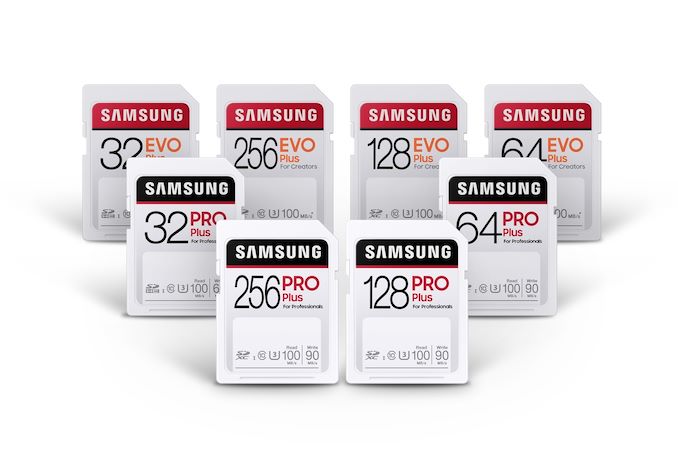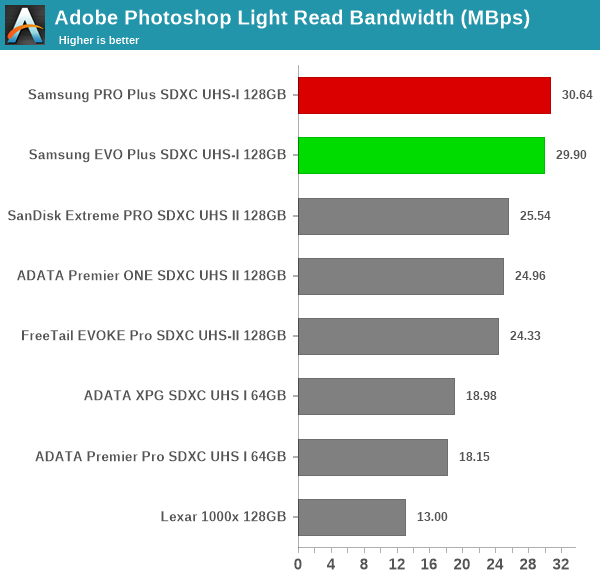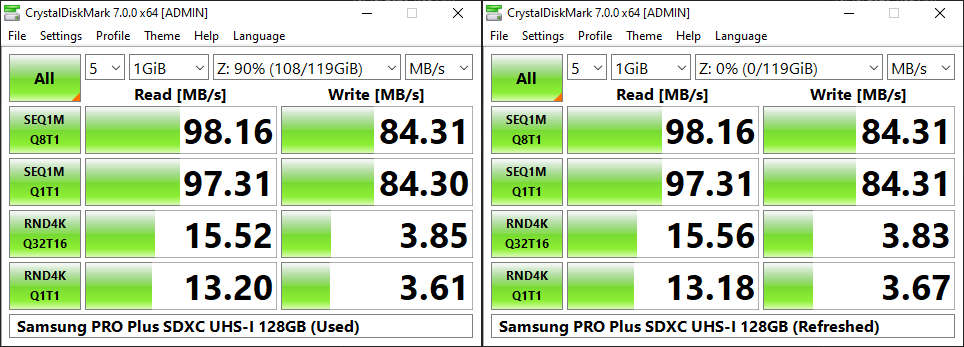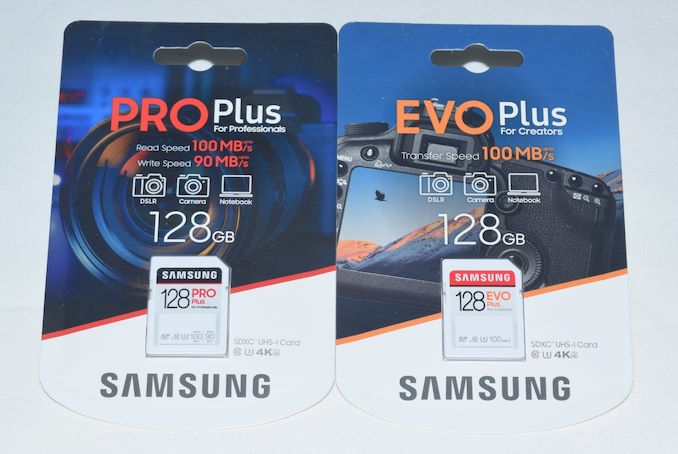
Original Link: https://www.anandtech.com/show/16159/samsung-pro-plus-and-evo-plus-sdxc-uhsi-128gb-memory-cards-review
Samsung PRO Plus and EVO Plus SDXC UHS-I 128GB Memory Cards Capsule Review
by Ganesh T S on October 14, 2020 5:30 PM EST- Posted in
- Storage
- Samsung
- flash
- Memory Cards
- SDXC

Samsung had last revamped their SDXC cards lineup back in 2014 to delineate them into the standard, PRO, and EVO categories. Since then, the company slowly phased out the full-sized cards from their lineup, and started to focus on microSDXC cards. This week, they are aiming to get back into the SDXC cards market for creators and professionals in the content capture market segment. Two new product families are being announced - the PRO Plus, and the EVO Plus. Both families are UHS-I cards, with the PRO Plus aimed at professionals, and the EVO Plus at creators. Samsung sampled the 128GB capacity cards in both families ahead of the retail launch. This review takes the cards out for a spin and attempts to analyze their value proposition.
Introduction
SD (Secure Digital) cards were introduced in 1999, as a follow-up to the existing MultiMediaCards (MMCs). Its miniature form-factor enabled it to gain traction even in areas dominated by CompactFlash. Its popularity spawned two follow-ups retaining the same form-factor - starting with SDSC in 1999 for capacities between 1MB and 2GB, we got SD High Capacity (SDHC) in 2006 (up to 32GB) and SD eXtended Capacity (SDXC) in 2009 (up to 2TB). The cards also come in various sizes - standard, mini, and micro. Currently, the standard and micro sizes are more popular in the market. SD's popularity and affordability has meant that almost all consumer cameras come with a SD card slot.
Samsung has launched the standard, PRO, and EVO line of SD cards back in 2014. This week's launch of the PRO Plus and EVO Plus lineup marks Samsung's re-entry into the full-sized SDXC card market. The PRO Plus family, as well as the EVO Plus 128GB and higher capacities are UHS-I rated with a U3 (UHS Speed Class) rating. The Class 10 Speed Class / U3 rating guarantees a minimum sequential write speed of 30 MBps. The 32GB and 64GB EVO Plus cards have a U1 rating. Both families have four capacity points currently - 32GB, 64GB, 128GB, and 256GB.
Samsung touts the robust construction and reliable nature of the cards by advertising them as '7-multi-proof' - protection against water (survival up to 72 hours under 1m-deep seawater), extreme temperatures (-25C to 85C operating, -40C to 85C non-operating), wear-out (tested up to 10K mating cycles with a SD host), X-rays (100mGy/210 seconds), magnetic fields (up to 15000 gauss), accidental drops (up to 5m), and shocks (up to 1500g for 30s).
Samsung supplied us with retail samples of the 128GB PRO Plus and EVO Plus cards to put through our comprehensive memory card evaluation routine. Prior to taking a look at the performance numbers, we take a look at the testbed setup and evaluation methodology.
Testbed Setup and Testing Methodology
Evaluation of memory cards is done on Windows with the testbed outlined in the table below. The USB 3.1 Gen 2 / Thunderbolt 3 Type-C port enabled by the Intel Alpine Ridge controller is used as the host port for benchmarking purposes on the testbed side. SDXC cards utilize the Lexar Professional Workflow SR2 SDHC / SDXC UHS-II USB 3.0 Reader along with a microSD to SD adapter. The reader was placed in the Lexar Professional Workflow HR2 hub and uplinked through its USB 3.0 port with the help of a USB 3.0 Type-A female to Type-C male cable.
| AnandTech DAS Testbed Configuration | |
| Motherboard | Intel NUC8i7HVB |
| CPU | Intel Core i7-8809G |
| Memory | Corsair Vengeance DDR4 SODIMM 32 GB (2 x 16GB) DDR4-2666 @ 18-19-19-39 |
| OS Drive | Intel Optane SSD 800p SSDPEK1W120GA (118 GB; M.2 Type 2280 PCIe 3.0 x2 NVMe; Optane |
| SATA Devices | Intel SSD 545s SSDSCKKW512G8 (512 GB; M.2 Type 2280 SATA III; Intel 64L 3D TLC) |
| Add-on Card | None |
| Chassis | Intel Hades Canyon NUC Chassis |
| PSU | Lite-On 230W (19.5V @ 11.8A) External Power Adapter |
| OS | Windows 10 Pro x64 |
| Thanks to Intel and Corsair for the build components | |
Our review workflow for memory cards test the following aspects.
- Sequential writes and reads (fresh pass)
- robocopy benchmarks (AnandTech DAS Suite) with performance consistency evaluation
- PCMark 8 Storage Bench (selected workloads)
- Sequential writes and reads (used pass)
- CrystalDiskMark sequential workloads (used and refreshed)
The justification for each of the tests and the details of how they are framed is discussed here.

The new Samsung cards provide very good performance for the rare scenarios where software needs to work on files directly off the cards without importing them into faster storage first. In fact, they seem to be better than the UHS-II cards in some of the workloads.
Performance Restoration
The traditional memory card use-case is to delete the files on it after the import process is completed. Some prefer to format the card either using the PC, or, through the options available in the camera menu. The first option is not a great one, given that flash-based storage devices run into bandwidth issues if garbage collection (processes such as TRIM) is not run regularly. Different memory cards have different ways to bring them to a fresh state.Based on our experience, SD cards have to be formatted using the SD Formatter tool from the SD Association (after all the partitions are removed using the 'clean' command in diskpart).
In order to test out the effectiveness of the performance restoration process, we run the default sequential workloads in CrystalDiskMark before and after the formatting. Note that this is at the end of all our benchmark runs, and the card is in a used state at the beginning of the process. The corresponding screenshots for similar cards that we have evaluated before is available via the drop-down selection.

The CrystalDiskMark numbers show that refreshing the card with the formatting tool works. It also importantly serves to back up Samsung's claims about the read and write speeds for the cards.
Concluding Remarks
The Samsung PRO Plus and EVO Plus 128GB SDXC UHS-I cards successfully completed our intensive benchmarking routines. It showed leading performance numbers in the short-term tests compared to the 64GB UHS-I cards we had reviewed before. Against the UHS-II cards (that are priced much higher), the numbers do not stack up (as expected). However, in the testing after long-term usage simulation, the performance of both cards is disappointing - with even the claimed U3 speed ratings not being obeyed. Surprisingly, the EVO Plus seems to behave a bit better compared to the PRO Plus - we only hope that the PRO Plus has better endurance for the little extra that Samsung plans to charge for it over the EVO Plus.
In addition to raw performance and consistency, pricing is also an important aspect. This is particularly important in the casual user and semi-professional markets, where the value for money metric often trumps benchmark numbers. The table below presents the relevant data for the Samsung PRO Plus SDXC UHS-I 128GB SD card and other similar ones that we have evaluated before. The cards are ordered by the $/GB metric. Cards that have been EOL-ed are struck out.
| SD Cards - Pricing | ||||
| Card | Model Number | Capacity (GB) | Street Price (USD) | Price per GB (USD/GB) |
| Samsung EVO Plus SDXC UHS-I 128GB | MB-SC128H | 128 | 20 | 0.16 |
| Samsung PRO Plus SDXC UHS-I 128GB | MB-SD128H | 128 | 26 | 0.20 |
| FreeTail EVOKE Pro SDXC UHS-II 128GB | FTSD128A10 | 128 | 46 | 0.36 |
| SanDisk Extreme PRO SDXC UHS II 128GB | SDSDXPK-128G-ANCIN | 128 | 190 | 1.48 |
| ADATA Premier ONE SDXC UHS II 128GB | ASDX128GUII3CL10-C | 128 | 206 | 1.61 |
The two ADATA cards that are UHS-I in the above table have since been replaced by one V30-class version - the ADATA Premier Pro 64GB priced at $50. In light of this competition, the pricing for the Samsung EVO Plus and PRO Plus series is extremely competitive. The suggested retail pricing for the PRO Plus and EVO Plus cards for different capacities are $50 and $40 for the 256GB, $26 and $20 for the 128GB, $17 and $13 for the 64GB, and $10 and $7 for the 32GB version.
Overall, Samsung seems to be delivering good value for money with the new lineup. Performance consistency after extended usage would have been good to have, but that seems to be a difficult proposition for products targeting this price point.









